Looking at the supply-and-demand imbalances and structural changes in the labor market, and what it means for employers.
By Wolf Richter for WOLF STREET.
We still have the most contorted labor market ever, but there are some big shifts, and those shifts make sense. We’re going to look at this picture book backwards. So stay with me. There has been a lot of thinking about the “why,” but I’ll stick to the “how.”
Supply of labor is very tight.
We can look at the readily available supply of labor roughly as the people who are looking for work but don’t have work at the moment. There are different aspects to it. So here we go.
The number of unemployed people near historic lows. People are deemed unemployed if they actively looked for a job during the reference period and don’t have a job. People who didn’t look for a job are not deemed unemployed (retirees, students, day traders, etc.). The number of unemployed ticked up in October from September, to 6.06 million, but remained in the same narrow range since January, and remains historically very low. This is particularly interesting because over the decades, the population in the US has grown:
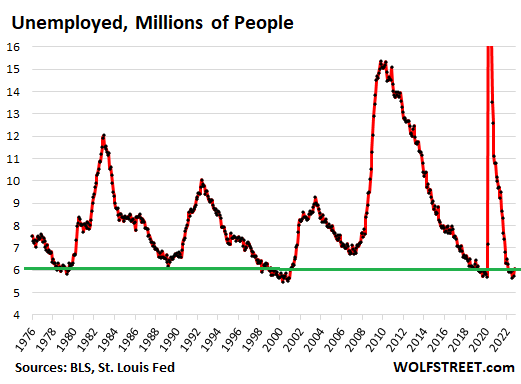
This data came from the Bureau of Labor Statistics today, which obtained it via its large survey of households.
Unemployment insurance claims near historic lows. Well-known companies, such as Lyft, Twitter, Carvana, etc., are now constantly in the news with layoffs. But the numbers are still small – in the hundreds or a few thousand per company – “small,” considering that even in the best of times, there are around 6 million unemployed in the US. And so far, many people that have gotten laid off have found jobs quickly, or already had jobs lined up by the time they were escorted out the building.
So the number of people who filed for unemployment compensation, at 217,000 in the week through last Saturday, as reported by the Department of Labor yesterday, was down a smidgen from the prior week and remains near historic lows.
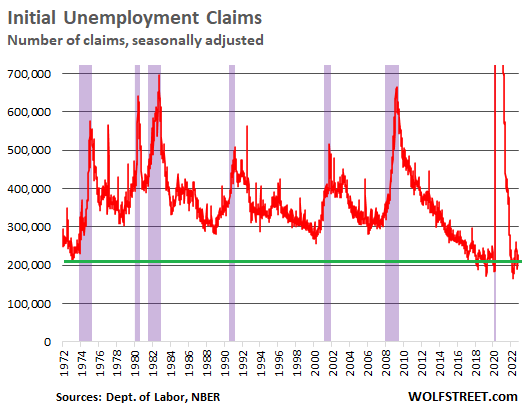
These initial claims for unemployment insurance are weekly and as close to real-time as we can get. They are based on actual applications for unemployment insurance – not on surveys.
What this low number means: across the US in total, not many people are getting laid off, and most of those that are getting laid off are finding jobs quickly, or already have jobs lined up, and don’t even bother to file for unemployment applications.
When initial claims for unemployment insurance begin to surge, it means that not only are more people getting laid off, but also more laid-off people cannot quickly find a new job and therefore jump through the hoops of filing for unemployment insurance.
Layoffs and discharges near historic lows. In parallel, the number of layoffs and involuntary discharges, a more lagging data set based on surveys of companies, reported by the BLS three days ago, fell from already low levels toward record lows, to 1.33 million people in September, down from 1.49 million in August, and down by 33% from September 2019:
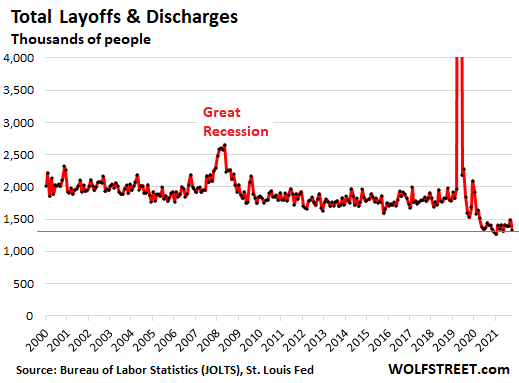
The overall labor force refuses to recover.
The labor force – people who either have jobs or are actively looking for jobs – dipped again in October, to 164.7 million people, according to the BLS today, based on its survey of households. It remains stunningly far below pre-pandemic trend.
This refusal – I use the term loosely here – of the labor force to get back to trend is the biggest issue the labor market has, and it’s a very complex issue, and lots of people are coming up with reasons for that. But it is what it is:
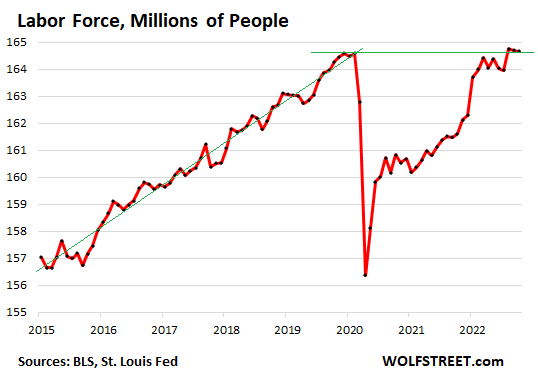
The labor force participation rate – the above labor force as a percent of the working-age population 16 years and older – dipped for the second month in a row to 62.2%, same as in January. It hasn’t improved at all this year:
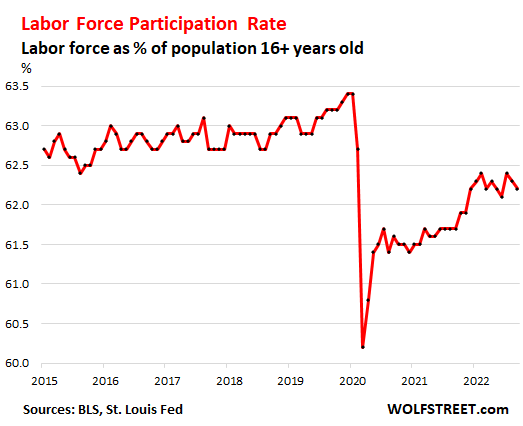
The prime-age labor force participation rate – people between 25 and 54 years old, which eliminates the effects retiring boomers have on the labor force — recovered a little more than the overall labor force participation rate, but also remains far below February 2020. In October, it dipped for the second month in a row, to 82.5%:
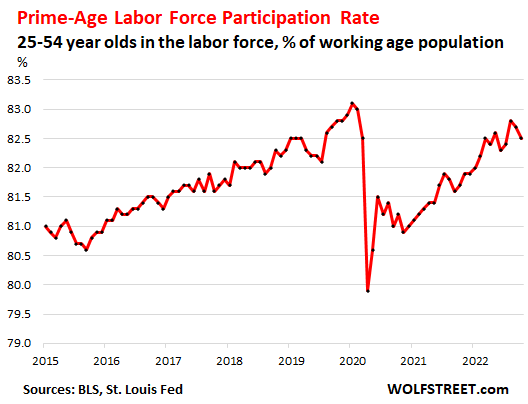
The working people.
The overall number of people who are working has stagnated all year. This includes people with all kinds of work, gig workers, entrepreneurs, the self-employed, people with regular jobs, etc. The BLS obtains this data via large surveys of households. It’s the broadest employment measure and is very different from the “jobs created” data that the BLS obtains via large surveys from employers; more on that in a moment.
In October, the total number of working people dipped by 328,000 to 158.6 million. It has been essentially flat since December and remains below the February 2020 high.
So the same households that said that the number of unemployed people in their households were near historic lows also show that the number of working people hasn’t risen since December and remains below February 2020. The green line denotes the pre-pandemic trend.
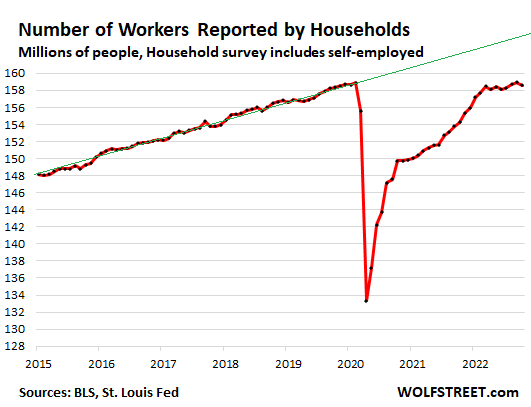
But employers added 261,000 workers to their payrolls in October. Over the past three months, they added 868,000 workers. So far this year, they added 4.07 million workers, according to surveys of employers by the BLS today. These are W-2 type employees, not gig workers and self-employed.
Over the summer, employers’ payrolls surpassed the pre-pandemic peak of February 2020 and have kept rising.
This continued relatively strong increase in W-2 type payrolls at employers has occurred even as:
- The labor force has gone nowhere
- The labor force participation rate has gone nowhere
- The total number of working people has gone nowhere.
This chart shows the rolling three-month total of changes in payrolls at employers. The latest three-month period from August through October came to 868,000 — the lowest since the reopening phase, but still higher than most pre-pandemic periods:
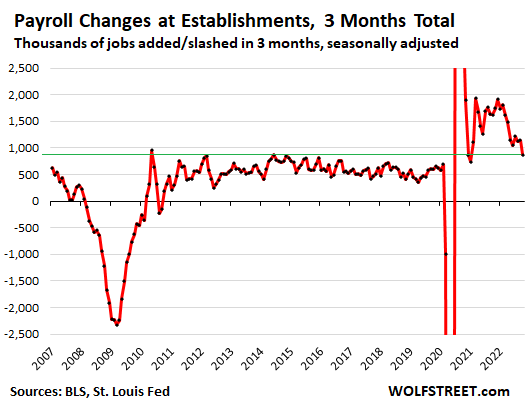
The self-employed switch to W-2 payrolls. The stagnation in the total number of working people (from the household survey) and the continued strong growth of W-2 payrolls at employers (from the establishment survey) shows that employers are aggressively hiring and offering wages and benefits that draw gig workers and the self-employed people onto their payrolls – and that makes sense.
This is a big shift: While employers created several million W-2 jobs this year, the total number of working people has remained the same, and we can conclude that a large number of gig workers and self-employed have joined the W-2 payroll crowd.
The chart below shows the trend. The total number of workers, as per household survey is always larger than the payrolls alone because the workers reflected in the household survey includes the W-2 employees plus all the rest of the workers. Since early 2022, that difference has been shrinking dramatically, from about 7.5 million workers in January, February, and March to just 5.3 million in October.
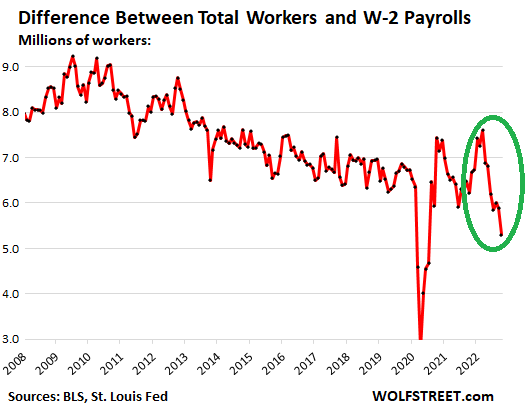
Unmet demand for labor.
Job openings were up by 51% from September 2019, at an astronomical 10.7 million. We got this data a few days ago from the Job Openings and Labor Turnover Survey (JOLTS) by the BLS. In manufacturing, the number of unfilled openings was up by 84% from three years ago!
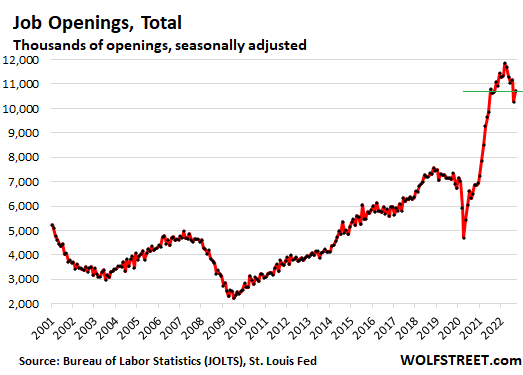
What gives?
The explosion of job openings last year, and the still huge unmet demand for labor depicted by these job openings currently, along with the very tight supply of labor, as seen by the labor force data, speak of the supply-and-demand imbalances currently in the labor market.
We can see the effects of aggressive hiring – such as offering higher wages, better benefits, improved working conditions – which turns into poaching workers from other employers, which creates that massive churn in the labor market that we can see in the historic number of workers who voluntarily quit their jobs because then can get a better job.
And this aggressive hiring also brings the self-employed onto the formal payrolls, as we’ve seen in the chart above.
And the payroll data from ADP showed just how huge the wage gains were for people who quit their job to get a better job. For overall private-sector employees, the median annual increase in pay amounted to 7.7% for the “job-stayers” and to 15.2% for the job-changers:
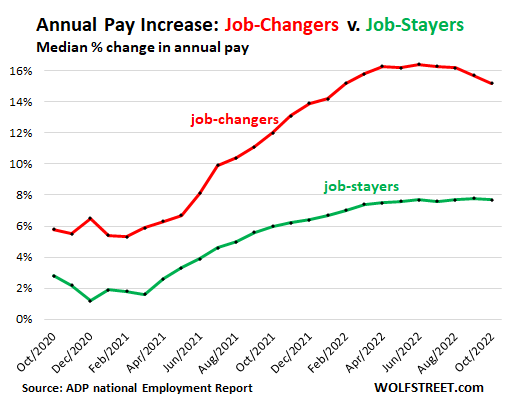
Did this labor supply force employers to learn a lesson?
There is now mounting anecdotal evidence that many employers are having second thoughts about laying off people at the first signs they see their revenue growth get into trouble.
During the pandemic, they were very quick dumping millions of employees. But then starting last year, when business began to boom, they had a hard time hiring people back, and they had this massive number of unfilled job openings, and they were left short-handed, and they couldn’t expand their business as they’d wanted to, and they had to offer much higher wages to attract people to fill the slots they’d created by laying people off, and they had to hire people with less experience than what they had in those slots before, and it hit labor productivity.
It makes sense that employers that have the financial resources would hang on to their employees. We’re not talking about the cash-burn machines that sprang up willy-nilly over the past 10 years during the free-money era that are now facing an existential crisis, but companies with solid business models that see a potential recession on the horizon but are reluctant to lay off people, knowing that the labor market has changed structurally, and that they will have one heck of a time bringing people back on board afterwards. And that would be a good thing for the workers, and for the economy.
Enjoy reading WOLF STREET and want to support it? You can donate. I appreciate it immensely. Click on the mug to find out how:
![]()


The current situation in tech space is much worse than shown here. This was one of the worst weeks after the pandemic with multiple layoffs including Stripe, Lyft, twitter and some others. There are plenty of people in the market looking for jobs. I personally know some job switchers who got laid off. when I look around, I believe we are about to enter a very deep tech recession.
Minuscule numbers, as I said in the article. A few hundred here a couple of thousand there.
By comparison, total layoffs and discharges in the US in the best of months are around 1.3 million per month. So the layoffs you’re talking about are not even a rounding error in the overall numbers.
But they’re hitting a very small corner of the employment picture fairly hard.
It’s really important to keep perspective when reading the headlines in the papers. “Lyft lays off 700” — wow, like HUGE, but all employers in the best of times lay off and discharge 1.3 million workers per month, and when it got tough they laid off over 12 million workers in one month.
Agreed, we haven’t seen huge Silicon Valley layoffs yet, but more layoffs are coming (Intel, Twitter?, etc) with hiring freezes reported (Qualcom, Apple?, etc) – but even that’s not massive yet.
What I’m wondering is if certain sectors (e.g. VC-funded, money losing start ups) get totally walloped (with companies such as Carvana, Snap, Uber, Lyft, etc going under or surviving with massive job cuts), which will affect certain areas a lot (Silicon Valley, Seattle, etc) but not the rest of the country.
So I agree with Wolf. These are small numbers in the overall picture. I just happen to be in that small corner.
And the rate of change is surprising. Not 6 months ago one could get hired in Amazon on a highly paid tech job without an interview. And now if one gets laid off, there is nowhere to go. People around me, including myself, are concerned about what next. That feeling is very recession like. But at the same time I agree that it doesn’t represent overall job market. There are plenty of other openings and market is strong.
My distant neighbor, who has apparently been living off a cash out refi, is not working. I have no idea if he is counted as unemployed, or if he’s “left the labor force.” I have a hard time believing he won’t suddenly become interested in working again at some point. He’s late 40s and a tradesman.
I believe the housing bubble has led to a lot of these distortions. People cashed out equity – or cashed in, however you want to put it. They got, in many instanced, $400k-$500k of Powellbucks parked on their household balance sheet, just waiting to be harvested. In turn, they stopped working and are just spending.
This is not where I meant this to nest.
seattleTechie-
The numbers you’re talking about are basically the largest tech companies. I’m curious if you’re seeing the same dynamic with smaller tech firms, many of which are private still and therefore make no public announcements.
Also, most non-tech companies still have a large tech workforce (albeit doing more boring in-house tasks) and for the longest time they couldn’t compete with tech firms for talent.
I wonder if we’ll finally see good tech people become available for smaller firms and non-tech firms that need them. That’s probably not what the workers themselves want, but it’s not as dire as not being able to find a job at all.
It’s very strange in tech. There are definitely a lot of very highly qualified people looking for jobs bc they were laid off.
But there are also a lot of highly qualified people who just want a new job. Lots of companies are making big changes as they downshift for the recession/downturn and that’s causing many to look. But there are also still tons of companies with openings.
The end result is tons of highly qualified applicants + tons of competition to hire them. I’ve never seen those two things go together, but here we are.
“But there are also still tons of companies with openings.” I’m also in the industry and I don’t see this. Many companies are laying people off and most of the other ones are doing hiring freezes. Some of the companies aren’t saying they are doing a hiring freeze because they will still hire certain positions but it’s basically a 99% freeze. I agree with SeattleTechie above and everyone I know is quite concerned.
Hiring qualified employees in a skilled labor field has been next to impossible for the past two years. Discussions today, that if we get to the point of such a slow down that we have to lay off people that the bottom of the barrel in quality go but we’ll need to maintain a level of strong, quality labor force through pain. On the other side of the pain when we need to add to our labor force that if we layoff too many now we’ll never get that level of quality employee back in the future.
I agree with both.
Many tech companies over hired. Twilio’s annualized share-based compensation is now 10% of market cap (after the drop today). It has the same product as 5 years ago with not significant increases in complexity.
From a techie’s perspective, I don’t think Twilio should have grown their headcount 8X over last 5 years.
From an investor perspective, who is okay paying out 10% of market cap to employees, when the company is not profitable?
There will be more tech layoffs. It’s hard to fight math.
It is still early on. An RV business crash is supposedly a pointer to the beginning of a recession, and I pose that the fall of the stock of big iconic businesses like Apple will tell us when it has reached the bottom. I can picture things taking their sweet time going there, and housing will go down too because you can’t pay these crazy mortgages without a similarly crazy salary. Silicon valley has increased salaries indecently in the past year (like 50%, or more for top performers, it is also not unusual to get as much in stocks as in fixed wage). No matter how great these people are, in a recession their cost will become a liability, and smarty pants from good schools will take over at lower cost. I can see that wage pressure may remain high for a while, but in the bay excess has to be removed. Also because margins will eventually crumble: if we don’t produce more or more efficiently, and inflation excludes a growing portion of consumers who sees negative wage growth (not everyone is changing job), further wage growth will only accelerate the downturn.
Thanks for the breakdown, I had many of those very questions as I read the data this AM. One topic that I am still wondering about is how the demographics of age (and maybe immigration) may be contributing? Anyway, fine work.
Soft landing watch the stock market, inflation is entrenched.
Tell me why it’s not, rarely has inflation been negative enough to erase the govs mistakes. Please call it out, I would hate to catch a falling knife. Keep watching it and then come to the same conclusion as me, then you will be as late as the fed. Inflation is entrenched because the gov needs it to be… 1 because gov works on YOY numbers, which means they needs to increase inflation to meet 2% over point something. 2. Because gov is FU to non rich people. The motivation is they own assests, stocks and realestate. They will add more debt to US to justify spending and B.S people to sell it. You seen it ” oh, we promise to stabalize bonds!”
VERY scary numbers far damn shore Wolf, and thanks for the clarity and thorough presentation of this extremely important aspect of the economy!
Some of us saw this coming many years ago in the construction industry when the biggest challenge, by far, was the lack of qualified help.
The one that would seem to indicate best guess of situation going forward is the number of workers reported by household well below the ”trend” line and appearing to go lower, indicating the number of folks MIA because of excess morbidity from covid for sure, and perhaps paranoia about being in any kind of steady group situation by many who know they are especially susceptible to that kind of contagion.
Why I am in favor of increased LEGAL immigration.
Immigration isn’t a great longterm solution. What we need is to end the cultural stigma attached to blue collar work and increased education for the trades. There’s virtually nothing blue collar offered or promoted in high school and trade schools are few and far between for many people.
Peachy, I worked with a group that promotes the trades in high schools in our county for 8 years. There wasn’t a lack of promotion or programming available — parents were NOT interested.
The average apprentice in Ontario is now over 27 years of age. This is a serious problem.
eg is correct.
The parents are not interested in their kids working harder than they did. So they want them to be white collar.
We had three businesses (hardware, auto body, paint) close here because their kids didn’t take up the mantle. Their parents didn’t want them to do the hard work that they did.
The Big Tech contractor space will likely feel some of the pain Powell is talking about. Companies like Microsoft, Google, etc. employ half their workforce through contractor arrangements, so they don’t have to pay incentive compensation. When the times comes to lay people off, they can cut contractor numbers by 20-30% quietly, without having to announce a layoff.
Big oil and energy-related companies are doing the same. Heck, I worked as a consultant to Big Oil since 1986 in two small private firms, one my own. They use LOTS of contractors and when things get tough, the contractors go away.
It’s okay. Most are BS jobs anyway and BS products like the tweetie.
Maybe those overpaid engineers and VCs can get real jobs and produce something useful for society, like teachers or doctors to fix the public education and Healthcare disasters.
Or get this Comprehensive Green New Industry going in HIGH GEAR before it’s too late…if it isn’t already
Can’t help but wonder if one million deaths from Covid has had some impact on these numbers, as well as the number of workers with long Covid. Not to mention the number of Boomers who had enough of work with the pandemic and were in a good financial position to retire.
How does Fed get out of the corner it has painted itself into: relying on old unemployment metrics in a new employment world?
Eventually brings back the old world…mass layoffs in a severe recession?
Does it matter? Inflation. Fix price stability or nothing else works. He’s said it so many times now.
Look Ma, I fixed inflation!
Ma???
[Ma is dead. Nice job, junior.]
I think this means that either inflation eats away the savings of the retirees to force them in the labor force or the Fed needs to set rates extraordinarily high like 15% to compress margin of a large number of employers to force layoff and create balance in labor market. Since Fed has signalled 5-6% as terminal rate and is unlikely to do a Volcker so early in tightening, scenario 1 of inflation ravaging savers seems more likely to me. What a mess! Will I need to pay 20$ for a 6 inch subway when I could get a footlong for 5$ a few yrs back?
The system, banks, companies, consumers and government are all more highly leveraged than the Volcker years, a lot more. I am betting that we will have a massive train wreck in the system before we get to a 6.
Fed is squeezeing debt And leverage out of market,for little people,anyway look at bostic it’s corrupt
@Capitalist: “I think this means that either inflation eats away the savings of the retirees to force them in the labor force….”
Many retirees are “skilled out” of the current workforce and will not find a decent job again. Many are not physically capable of a job on their feet all day.
Some may get hired by stores like Home Depot (put on a wait list), and some by Burger King or McD’s if they can speak fluent Spanish.
Three cheers to Doctor Covid:
1. For turning the labor market upside down.
2. Demonstrating that rush hour traffic congestion is entirely optional.
3. Ergo: most downtown office space is worthless.
4. And most passenger flights are a complete waste of resources.
All specific and measurable ways of addressing climate change.
Hear Hear! That’s lemonade out of lemons.
The Canadian way is to bring in millions of humans a year to drive down wages.
That used to be the American way, too…but we got stupid.
Donald Trump put a stop to that loophole, and Americans enjoyed the job market while he was in power from 2016-2020.
Like him or not, he helped wages go up in the USA.
Meanwhile in Canada, we have a virtue signalling government which aims to erode the standard of life for Canadians.
Don’t exaggerate. It’s only a million every 2 years!
I think we have gone absolutely insane with this. Now they want to pave over the greenbelt around Toronto … to build more houses … which they need because of the 1500 people a day we are bringing in.
Insane.
“We’re not talking about the cash-burn machines that sprang up willy-nilly over the past 10 years during the free-money era that are now facing an existential crisis,”
But I am! 😆
I get that the pixel jockey layoffs we’re seeing are miniscule on a national level, but they make up a disproportionate number of jobs added this century in the Bay Area, especially in SF and the southbay/peninsula. We might be about to see Bay Area Techxodus II: The Return of the U-Haul Traffic Jam on Eastbound I-80.
It probably matters more because are the better positioned jobs. The lucrative ones people want one day as they rough it out somewhere else. Not everyone is doing great fun exciting work nor are they getting the same high compensation. If those jobs are cut, where does one move up from? If these experienced people are moving down because a job is a job in hard times, where does that leave the rest?
It’s easy to sit around tossing numbers but it’s another to try to project the future.
two beers,
As a former resident of the Bay Area, I’m curious…. When did Techxodus I occurr?
I’m not Two Beers, and would not presume to speak for him.
IIRC, it may have been after the DotBomb of 2001.
It was 2002, following the dotcom 1.0 implosion. There were uhauls everywhere you looked, and cheap, decent apartments in SF were so easy to get. Those were the days…
Nah Alba, THE good old days were when you could get a decent flat, sometimes 2 bedrooms, in most areas of SF and east bay for $50 per month, and pay for ”odd jobs” was $5 per hour in cash…
Was easy to work a week a month to pay all the NEEDS in those late sixties/early seventies years…
Yeah. One of the modes of travel used back then was driving rental moving vans from back east to the west coast. The MANY people who came out to clean dope even used it. (usually had an old motor home, though) Think there was even some pay involved. Not sure how they brought back trailers, though….truck or train? But renting them was free.
They have had constantly improved dope cleaning machines for years now (more people replaced by robots!), but still need a few people to run machines and then fine clean the buds.
“pixel jockeys”…hadn’t heard that one. Thanks. Been looking for a good coder slur, as I can’t stand to see them referred to as Engineers. Chip makers are Engineers. They just learn computer languages and how to play with/simplify them. Far above programming an 8086 in hex which I did for a class, to just add and subtract a couple numbers.
Knew “parts changers” (poor mechanical techs), “board jockeys” (poor electronic techs), though.
Digital Dorks
i spent a whole day back at my first software job back in 1988 tracing through uncommented Assembly language code , just to discover, “oh it’s a do loop!”
something u could see inherently Just by looking at uncommented the code today. actually even then, just not in Assembly language. that was soul crushing work.
c’mon youngsters,,, try ”fixing” errors in binary, aka ”machine language” when the only available printout was page after page of zeroes and ones…
THAT was soul crushing, and most folks lasted less than a year, even after months of ”training,” and lots of support…
And, of course, we programmer trainees in the sixties heard endlessly from the older folks about the challenges of finding the one ”tube” out of the gazillion in the computer that was housed in a room 20′ x 40′ x 20 ‘ high…
IIRC, it took three folks times 3 shifts times 7/24/365 to keep it functioning at all, with about the same capacity as current coffee makers,,, if that.
haha. yeah, u got me way beat. i remember hearing stories of programmers trying to keep their punch cards in order, only to have them splay all over the floor. i loved the logical process, but not enough to endure that sh&t.
The thing is that lots of these companies, such as Twitter, switched to WFH. Their employees may no longer live in the Bay Area. Maybe they moved back to St. Louis or wherever, with their big Bay Area salaries.
San Francisco lost something like 8% of its population over the past two years. WFH is one of the reasons. Some people moved but stayed within driving distance of San Francisco (Foothills, Central Valley, East Bay, Lake Tahoe, etc.), others left the state. So these layoffs in the Bay Area may actually hit other parts of the country.
My homeowners insurance company sent me a letter bragging that they went WFH for most if not all of their 25,000 employees. Well, it worked well for them, but it didn’t work for me. They couldn’t process a simple claim when they were all working in a common location in San Antonio. Now their claims process is completely broken. 25,000 people working in different states on computers. No one visiting your house after $20,000+ damage. I wonder how all those folks in Ft Myers are doing living in tents at the end of their driveway filing claims with these crooks.
I remember when usa was going to be a technological wonder only build high dollar manufacturing. Cat,Boeing,Microsoft ibm,then our kids sat on there ass played video games ,while mom and dad worked there ass off .Now we have kids that don’t have a idea about hard work or responsibilities.But it will all change with the reset Soup lines and slaves to survive
Yes, that’s definitely the problem. Time for your meds old man.
OK, Zoomer. :)
What’s your answer besides criticizing
Go watch Robert Mitchum talk to Dick Cavett back in ‘71 about how much he loved his manufacturing gig at Lockheed.
Maybe it’s just my region of reference, but I do not perceive many lazy kids sat around on their asses. Maybe there’s kids who’ve grown wary, post-Covid, of the dubious virtues of careerism & the exhaustion, boredom & heart disease which underscore so much of it.
Cutting social security and medicare. There’s your answer :)
@phoenix: Once they cut SS and Medicare, Dad will have to kick those kids out of his basement into the street telling them it’s time to make it on their own!
Yep, US companies shipping all their manufacturing overseas is definitely because of the video game playing, and not because of federal policies.
I am no expert but I think in 1970s inflation, wage price spiral was created by strong union negotiation. This time we might get it from lack of labor force. Fed can neither increase labor supply or reduce checkable deposit or cash (from refi or stimulus or ppp ) from accounts of retirees. so inflation will keep running hot for years and suck up the savings and force people back onto labor force. that means at some point inflation expectation could get unachored.
I think inflation got unanchored when people bought a car and two years later sold it for more.
On August 15, 1971, President Richard Nixon officially closed the gold window.
Inflation expectations already seem unanchored talking to everyone I have recently. No one seems to be saying “wheww, glad that’s over!”
So you’re saying we have an environment where it’s relatively easy to change jobs, or find another one if laid off. It makes me wonder why we even have six million collecting unemployment. They either prefer collecting to getting another job right now (they are picky, and/or have other resources or assets to cover them still), or are serially unemployable misfits who bounce from job to job to get fired and live off the dole.
It sounds like this is a baseline number of unemployed that will always be there., and this is as good as it gets for the labor market. No wonder strikes are increasing. Inflation in this scenario is bound to rise more. So far to go.
It used to be very difficult to collect unemployment, it didn’t pay well, and it didn’t last long. If you did qualify, they used to make you prove you were actively seeking jobs, and if you weren’t they would cut you off immediately. While I never did it, I heard complaints a few times way back in the day from people who were annoyed at the difficulty of the process.
That’s how it should be. Allowing people to sit back and milk the system is a really disgusting recent development. The “extra $600” they just gave people was an outrageous act which set a really horrible example. Something like that should never, ever happen again. It distorted the labor market in ways unimaginable. That in conjunction with allowing people to stiff the landlord and all of their payment obligations is what brought us to where we are today.
Re-run of Flea…..see Cyrus response.
Did you ever get that job at Taco Bell?
Got laid off didn’t show up for work 🤣
Depth Charge,
Cookdoggie spread a lie. 6 million people are unemployed; only 1.4 million collect unemployment insurance. The remaining unemployed get nothing.
See my comment below.
Nah, just ate their breakfast jacks while collecting un. Smoked dope the rest of the time and watched cartoons on TV.
Lied on the looking for work forms, learned they never check, anyway.
The “extra $600” program was a vote purchasing initiative if I’ve ever seen one. The timing of that program was not a coincidence.
As for the tightness of the labor market, I’ll say it again: long covid is contributing to it. The pandemic is far from over for the people who were unfortunate enough to carry the illness symptoms forward.
Some of those people would like to be in the labor market but won’t be until the brain fog, severe fatigue and other symptoms abate. Western medicine has no treatment, medications or cure for long covid. It is not an understood illness.
The CDC estimates “up to 23 million” Americans have long covid. A percentage of those have symptoms severe enough to keep them out of the labor force.
Agree, western doctors are useless for long covid. Had long covid since about 2015. Brain fog, fatigue, the works. Chinese doctor says it’s heatiness and to cut back on the Irish coffee for breakfast.
Cookdoggie,
1. “…why we even have six million collecting unemployment.”
Wait a minute… 6 million unemployed — meaning looking for a job. They do NOT all collect unemployment insurance.
Separate data from the Department of Labor shows that last week 1.4 million people collected unemployment insurance. The rest of the unemployed didn’t collect unemployment insurance, maybe because they expect to get a job pronto and haven’t bothered to file for unemployment insurance or whatever.
2. That 6 million unemployed is historically LOW — out of nearly 160 million working people. There is always churn in the labor force. People quit their job, or get fired from their job – and so they’re not even eligible to collect unemployment insurance — and they start looking for another job, and so they’re unemployed for a few weeks, but don’t collect unemployment insurance. This is part of the dynamic labor market.
Hi Wolf,
About number of employed people, Do you think that an uptick in added payrolls statistics that recently came out and translated as a good news in media, is actually a noise and soon we will see less job opportunities and then layoff will be started
Every single word I would say about it I already said in the article LOL
Go look at the workforce participation rate.. no wait I’ll link it:
https://fred.stlouisfed.org/series/LNS11300060
Approaching ten year highs. We are pretty much at max labor rate for prime age workers.
I’m seeing some businesses offering $10k sign on bonuses to tradesmen. That’s how tight the labor market is.
DC-hm, US Army was offering $10k ‘re-up’ bonuses for several MOS’ in the early (post-draft) 1970’s (albeit for a six-year commitment). $10k today?
May we all find a better day.
Re-up for VRB program.
Also got early out if you extended for 6mo.
And even a slick sleeve’s family got $10K if you came home boxed. Real tight labor market!
But still had 1/2 M in country.
NBay …had wàay too-much fun watching the bn retention staff nco trying to get me into an enlisted hitch after I told him ‘yes, if I got flight school’, knowing he never would as I was too-tall for first seat on contemporary rotary wings. He must have had some serious incentives to put in all that effort…
May we all find a better day.
From reading expert analyses and looking at historical data, I believe that unemployment will have to get to 5-6 % for the inflation to get under 5%. And the longer these numbers take to correct, and the longer the asset bubbles take to deflate, the more brutal will be the layoffs at the end. Same, or worse, than the layoffs of Q4 2008.
Its like these tectonic plates pushing against each other and none of them wanting to budge. The result is working towards an economic quake of 10 on the Richter scale.
[ Mr. Wolf, just coincidence :)]
What the FED expected in their inflation fight and what’s currently happening are two very different things. When “transitory” didn’t pan out, they expected inflation would quickly wilt after they aggressively started raising rates. Ain’t happenin’, which is why you’re now hearing from J. Pow that rates are going to be higher than initially expected. Mortgage rates are probably going to 12%, minimum.
12!!!!??!! That is unfathomably high.
Jshells wrote: ” 12!!!!??!! That is unfathomably high.
Pfftt. 12% is nothing. I still expect to see interest rates above 20%.
I have memories of my 18+% mortgage in 1981. It usually occurs in a bad dream now and then. Real high mortgage rates still can happen though, but probably a low probability.
it’s all relative. what’s the rate of inflation at that point? is there still a functional sovereign bond market? are oil producers still accepting $USD for the product? have the global south created enough non $usd global trade
to cut the legs out from under the $usd? how many ppl have starved or frozen to death through structural market failures? etc etc
The interest rate increases are NOT WORKING! Companies that are essential to running and maintaining critical infrastructure are just going to raise their prices to accomodate the increased financing costs. They won’t suffer one bit. Powell is just following the market rate upward and not getting ahead of the curve. Inflation is still 4 to 5% above the cost of money, and really 8 to 12% if you figured inflation correctly rather than the BS you get from the government. He is following the same pattern that the Golf Cart Manager and former failed Fed Chief under the failed President Carter, Miller followed. It didn’t work then and IT WON’T WORK NOW!
By the way, I just noticed, sales of houses picked up here in the Swamp. Even at 7% and higher mortgage rates people are buying like there is no tomorrow. Creative financing is coming back. Interest rates have to go a lot higher to dampen demand. A lot higher.
I picture J. Pow at home pounding highballs, screaming “this goddamn inflation isn’t slowing! My legacy!”
You’re right, it’s not, J. Pow. Shoulda uncorked a couple of those 200 basis point hikes like I suggested.
Well, something’s gotta bring the labor market into some semblance of equilibrium. As long as we keep running such a huge gap between labor supply and labor demand we’ll continue to experience excess inflation.
Brining these two into balance may very well require more than just a recession, it may require a long-term reduction in the standard of living. That’s something few people are willing to admit (or even recognize).
Here in Austin, Facebook just announced that they are not going to occupy their new 600k SF office lease, and Google is supposed to announce the same for their new building in a couple weeks.
This to me means big layoffs are about to come. I could be wrong, but I think the big guys are all planning big layoff announcements soon. Not to mention all the startups that are just going to go under because of lack new funding.
We are also seeing a lot of development projects being postponed or halted. The construction industry is about to take a big hit as well.
I am a believer that 1st quarter we are going to see completely different job numbers than today.
20 years ago it might’ve meant recession, but nowadays you might be underestimating the power of WFH
Facebook signed that lease 8 months ago, Google kept building through covid. If this was about WFH, they would have not moved forward with these spaces a long time ago.
The Metaverse at Meta has turned out to be a complete multi billion dollar disaster.
As for building, one those contracts were signed back in 2019, Google was obligated. It’s not like you can back out of a deal, plus they probably financed at 2%.
Chris L
I agree. The tech layoffs have been fuelled by terrible business models that are in the process of being flushed out, and more tellingly, from tech firms suffering from substantial reductions in advertising revenues.
Needless to say, advertising flows from all manner of mainstream consumer businesses. If they have to be, and they will, jobs in these mainstream enterprises will be next to be cut from operating expenditure. So, advertising budgets get slashed first, jobs second, doom loop third.
In particular, I think about the consequences to ensue from the flawed economics of debt-funded stock buybacks at major corporations ahead of further monetary tightening and greater losses in market cap.
The consumer spending frenzy, often anecdotally referred to in these comments, represents excess money that isn’t going to recirculate back to the consumer. It is being vacuumed out by higher rates and QT through a complex array of channels. This process will lead to more conspicuous job losses down the line.
The accumulation of excess snow on a mountain top is also entrenched. Then there’s an almighty crack and the snow instantaneously submits to the law of gravity.
Facebook is even abandoning their new building in metaverse. Was going to be taller than Salesforce.
Agree CL, but will start right after next week’s national election, no matter which side of the aisle predominates.
Kinda sorta has been that way a lot of times, with the winning party determined to make sure folks know where the GGUVMINT largess is coming from…
Is Government largess causing people that could work not to enter the Labor Force and increasing the number? How does one explain the difference between Labor Force participation and employment?
Fear not John Knox. Team R has been working hard on a plan to reduce Social Security and Medicare after they take over in November.
Grandma can work past 90 in your favorite bar/restaurant.
Why not cut Parma benifits,feeding doctors office lunch,no more golf course excursions to Hawaii.reduce drug prices to Mexico and Canada prices .Oh it won’t benifit the well to do everything is corrupt usa puts China Russia to shame
Old-don’t know many grams who will get hired for those positions at 75, let alone 90. (I know, ‘s/’ is on. Not to worry, though, the contemporary ‘Murican Way seems to be that time will provide the ultimate wishing away of all ‘issues’ with little actual commitment from the citizenry…).
May we all find a better day.
Total b.s.
Right-winger porn?
I have a good friend, civil engineer by education, who has done well for himself. House paid for, got some mutuals and a fair amount of cash… very frugal guy. He stopped working about 3 years ago before the pandemic. He does some side gig engineering stuff here and there but basically just chills around town. He could go back to work, just doesn’t want to.
I think this article is the data behind my friend and those like him, more or less. It’d take a really strong offer to pull him back in- and he’s a dang good engineer. I also imagine a totally tanked market might do it, maybe. My feeling is this article describes two types that out there- the ones like my friend and those that are just burning through their refi cash like someone else mentioned. Guess there’s a fair amount of both based on this article.
My buddy mentioned to me about some of his investments and whatnot a while back. Told him to start reading wolfstreet so he doesn’t get hosed by some shmoe.
Totally agree that this kind of person is contributing to the distorted labor market and the low participation rate. I have a first hand account because I am one of these people who left traditional workforce
It all stems from the underlying issue of too much free money no doubt but there is a fundamental change of the psyche of working age Americans.
America doesn’t work without workers period
What low participation rate?? The 25-55 is almost at ten year highs.
I’m just like your mate. Young, smart, hardworking, frugal, with no debt. I was on top of the world career wise 3 years ago when it dawned on me, “what the heck am I doing all this for?” I’d made enough. I was tired of the grind and paying all the taxes. I quit and became poor on purpose. It would take a huge offer to make me get back into the game. Money doesn’t really mean all that much to me anymore but when I was in debt…money was the number 1 thing. Now that I don’t owe anyone anything, I’m no longer a slave to the system. It’s a game changer.
As long as you can get your nourishment.
And good health insurance.
health costs are more a concern if u choose to stay in the USA AND get sick.
much cheaper health care options outside the USA. I think many folks make the mistake of doing xyz in the USA simply to maintain health insurance. they are basically kept slaves to the system by believing in the self induced “health care crisis” narrative the Dems started years ago.
Not having health insurance means your one car accident away from disaster.
There’s a growing number of people just like you. Maybe it hints at the possibility of a more unified consciousness here in the west. It seemed like whenever the batteries suddenly died on the great noise machine during the first few months of COVID, the resulting stillness jolted a lot of people from their waking sleep. Whether it lasts, we shall see; but I definitely think it figures into the prime labor participation numbers.
Ditto for me (except I’ve never had debt). And I’m betting you are not poor.
Jeff D-mindset is vital. Film director Mike Todd said (many years ago): “…I’ve often been broke, but I’ve never been poor…”.
May we all find a better day.
Dollar Stretcher… same here. Worked long hours since I was 16. Retired at 51 in 2019. Key to our fortune is the many rentals we bought 2008-2015. I would guess a fair number of people who recently retired early also did well in the last upswing. My husband likes to tell people at dinner parties that he was 40 years old in 2008 which put him at the right place at the right time to acquire property at astonishingly low prices. The key, he says, was being born in 1968.
We had so many carried forward rental losses that we couldn’t take while we were working, my federal taxable income ended up being about 5% of our gross income last year. Big change because I used to pay Uncle Sam 150k in federal alone, plus a whole gamut of California taxes. Passive income is really the way to go to avoid paying taxes
This sounds great but I assume you don’t have kids. A lot harder to pull this off with children.
Correct no kids for me!
Couldn’t see bringing them into this world honestly
My parents are also divorced and sister is mentally ill so my confidence in the dynamic of the traditional family was shaken early on.
I would argue divorce and child birth rates also play into this new labor ideology.
America was designed to have working families buying houses. American dream is dead for many
I’ve got 2 sons in HS. The best part about what I did is that now I’m available 24/7 for them. I missed so much of them growing up because I was always working. Even when I was there for them, I wasn’t really there if you know what I mean. I can’t go back and change any of that but I can move forward and be there for them now as they turn into men.
I have a friend who has a well paying jon 200k per year.. made money in market ..quit his job.. lost money..
Rejoined work force.
OK this is bit of a segue:
Re: layoffs. Musk has laid off about 50% of Twitter’s staff, with no notice…so suit filed.
Obviously with this abrupt firing, the ‘no compete’ clauses won’t be enforceable.
The point: there is a rival for Twitter all ready to go here: all that’s missing is money.
I assume the ex- C-Suite guys can come up with a few mil, add 10 mil from WR in the mezzanine round and do an IPO.
Seriously, this thing, Twit, just sold for 44 billion. Can’t the former staff create one worth 5 or 10 billion? Or 2 billion.
Suggested name: Spitter
Musk gave them notice in the form of 90 day severance package. That crap about WARN is misguided fiction. The fired workers literally got 90 days notice, and won’t have to work 1 minute, to get paid for next 90 days. Plus they still have their health coverage. The stupidity of media, lawyers, and everyday Americans never ceases to amuse. Does anyone have even one firing neuron left, and do more than 1 minute of critical thinking anymore, or do they just let these fictional headlines run their world ? Pathetic. So many people want to make musk out to be a stupid idiot. They regret their attempts repeatedly.
Well we know he was an idiot about Twit. He admitted he overpaid as he wriggled and writhed to get out. Then the judge of the Chancery Court in Delaware said: ‘times up, trial in October’. He was caught in his own web.
Further: everything he’s done for months lowers the value of Twit, including the mass firings.
I assume you are long Twit.
Paid for with one of the most overvalued currencies on the planet, TSLA stock. Not entirely dumb.
Twitter never needed these many people in the first place.
I bet most of the companies can do same with less.
Such is the magic of cheap money.
Your comment actually made sense until you started pontificating about the stupidity of everyone. Don’t you think Musk knew exactly what was required and he knew it because of his lawyers. If you’re referring to the lawyers who filed the lawsuits about WARN, that’s a PR stunt to create headlines. Very few, on either side, are as dumb as you seem to think. Unless of course you know most of your comment is nonsense. Is that one neuron you have left still firing?
Nick Kelly, cut your losses.
Ilan is the boss, he can hire/fire anybody he wants. The days
of soft, elastic ceo are over. Ilan drained the swamp faster
than…
I was referring to his treatment of the execs. As I understand it, not even a meeting.
PS: Musk’s big complaint over months was that a lot of tweets were fake, bots, etc. etc. How firing half the staff improves this remains to be seen. So far not very well as some users are successfully pretending to be Musk.
I really wonder what’s going to be left of Twitter once the slimmed down version is clucking along with many of the revenue paying advertisers jumping ship?
I also assume many of the staff/engineers/pixel jockeys contributed something positive to the operation success when still working there.
It would be a shame to see this ending up as a money losing operation and a waste of not only purchase funds, but kicking out many good employees.
But, then again, this is what America is about these days besides starting three cold wars at the same time.
Twitter was always a money losing operation. Musk will change nothing.
SpaceX and Tesla never needed advertising.
“Obviously with this abrupt firing, the ‘no compete’ clauses won’t be enforceable.”
Non-compete clauses are against public policy in California and aren’t enforceable against any Twitter employee regardless of how they were fired. In fact, the freedom of employees to move around and seek better opportunities is a key feature behind the success of Silicon Valley. For all of its many faults and ridiculous red tape, this is one business issue California gets right. Talent will be attracted to a place where it can seek the best opportunities.
The previous comment was in reply to Nick Kelly.
This living standard that the successful enjoyed the last two years was not sustainable. The living standard that was built up to 2020 was not even real being built on artificially low interest rates. The reality coming will be very hard for most: a serious step(s) down in living standards, or walk the street a bankrupt homeless. What’s a coder to do when there is no coding jobs, or any high paying jobs? I predict it’s coming again like 2000 and 2008. Either flip Burgers or have nothing. That house? That equity? You never thought it would lose 50% and if it does are you washed? Living standards have always been pegged to interest rates. Now more than ever because debts make it more so. The current Fed rates can take us back to living standards of say 2003 or 2011 imho when debts start forcefully getting reconciled, if they were to keep them this high(er) and destroy the economy that bad. So many people think they can’t go bankrupt with all their houses and equity and stuff. I ask you, how would you be with houses 50% off, stocks 50% off, 401k 50% off, no job for 2 years…and all your debts being called due. Some maybe great, but many many will have gone bust being overextended buried in debt. And finally, if the system freezes with a lockdown type economy like in 2020, can you pull through for a year or two? So many go all in going up. A few step back and just stay safe with modest living standards. Time will tell, but it’s not telling yet. Maybe luck sticks around. Imho it doesn’t. Another swan will come. From Russia, or China, or the weather like drought… assassinations, middle east turmoil, sovereign defaults, run away inflation…too many to even consider. Time is hinting, not telling. Some do bidding wars, some do bidding safety. Life is a balance. Everything is a guess. My guess? Reunderstanding the definition of unsustainable and it’s ramifications. Also interpreting and quantifying storm clouds, color, quantity and strength, and applying wisdom to all applications affected without sacrificing peace.
I think a large part of the spending increase the past 10 years was wasteful and didn’t increase qualify of life that much. Why buy a $60k SUV when a $20k sedan will do? Why enroll kids in every event and program possible, when they can just play with friends or do something on their own? Why take that $10k vacation when a drive to a nearby state is a lot less hassle?
If people started rationalizing their spending a bit, GDP could growth could stop and it wouldn’t decrease qualify of life.
Today, people are not happy, overall. The consumerism train travels in a circle and has no destination.
This is beyond consumerism. I think they call this conspicuous consumption. I’ve read somewhere Japan went thru something like this before the crash.. Later owning an expensive car became distasteful.
Flash cars are already deemed desperate and gross by a lot of switched-on young Americans.
Using employment statistic to gauge the health of the overall economy can be deceiving. While part time employment is going up, full time employment is declining. The lowest tier of workers are making double what they were a couple years ago, but many of these jobs are part time and do not have the same benefits as full time employment. These part time jobs are also the most vulnerable in a recession.
Small business is being squeezed between a tight labor market, and the increased cost of labor forcing many to raise prices and cut quantity and quality, which alienates customers. Many small businesses are struggling to make a profit, and are just hanging on by their fingernails, and are questionable to survive a downturn in the economy.
The current strength of the economy is due is at least some part to the gains in income from the lowest income tier who have seen wages rise from the $7 range to the $15 range, but this demographic also tends to live at the upper limit of what they earn, and spend nearly all their income and save very little. Just as many factors contributed to make inflation worst now that at other times, there are factors in the labor market which have the potential to make a recession worse than at other times.
It’s kinda scary. i’ve been watching (at a distance) an internet friend begin to really struggle to find a job, any job. she’s well educated and has worked consistently doing all sorts of jobs for years and years, but the last couple of months she’s been applying with increasing desperation and just…getting nothing.
Is she old enough to face age discrimination? This is an insidious disease. And it’s really widespread in tech.
Immigration will also drive up inflation as well. Though they may not have the skills required in manufacturing tech and the medical fields they have the ability to find and create work for survival. What does become inflated is the demand for housing and rents continue to rise. An abandoned home in a small town in rural america where there are few jobs does not get counted in the survey for rents as we continue the decades long migration to the coasts and large cities. Food and energy though not included in the Fed CPE drives people to make changes in lifestyle and move to locations that reduce their costs for food and energy for survival (big cities with reductions in overall living costs but higher rents).
1) Nonfarm payroll m/m changes in Oct 2022 are zero and above. No losses. The mining and logging : n/c. Construction and utility : +1K each. Housing constructions are down, but road works are up. The largest increase was in education and health services : + 79K.
2) Making real stuff : mining : n/c, construction : +1K, mfg : +32K.
3) Since Feb 2022 the largest drops are in leisure and hospitality : (-)1M
and gov (-)0.5M.
4) Since Feb 2020, making real stuff : mining (-)52K, construction : +97K
and mfg : +137K. That’s not good enough !
5) Since NAFTA was signed in May 1997 M1 and M2 velocity dropped and never stopped. Comatose since 2020. Gov infusions cannot substitute banks lending and producing real stuff.
6) BKX, the banks index, dropped to July 13 1998 high, to 95.32 and bounced up.
Great analysis Michael!Always enjiyed it Keep it up!
How about the number of machines that have replaced humans?
Wolf, you have a typo in your graph title:
Differnence in total workers and W-2
Thanks :-]
There are two difficult issues that recently came to the front of workers minds:
1. Wait a minute they want me exposed to a pandemic virus and aren’t going to actually compensate me for the true risk.
2. I don’t know anyone who will have enough money to retire. Have we reached the point where you either clean toilets or you own them.
The ability to pool capital and form your own business has never been easier.The higher costs of running a top heavy corporation that also has to pay higher wages means market share is available to a lower cost supplier. Enter the newly laid off American entrepreneur with all the network contacts from a job they just lost.
The key to higher commodity costs is even higher commodity costs. Eventually market competition will steal market share from the inefficient.
What everyone is underestimating is the entrepreneur who can effectively compete and take market share. No customer or worker loyalty is ever guaranteed. America is based on competitive warfare that knows how to skirt rules and blindside the complacent.
The fed’s policies will open that Pandora’s box next year you will see millions relocate to where their brains snd labor can offer them a future. Many mid sized cities will end up on the road to Buffalo.
Don’t underestimate the American spirit of competition. Once awakened the margin collapses as market share shifts. The hedge funds that cornered “”good” zip code real estate will find those neighborhoods in decline, as people turn in their keys.
Next year will be totally unpredictable.
Does the surge in exports from the US matter?
It would seem like the record level of US exports should matter for employment.
Most of the surge comes from the surge of exports of petroleum, petroleum products, and natural gas (LNG). And yes, for the energy sector and related manufacturing sectors, etc., it has been good.
US natural gas production hit a new record. The US is the largest NG producer in the world, and a major exporter. Crude oil production is approaching record before the pandemic. This industry is hopping, and struggling with a labor shortage. Those are high-paying jobs.
The cause of this is Covid and/or the vaccines. The Brookings Institute did two studies, showing a minimum of 5,000,000 left the labor force due to Covid deaths or long Covid. 1,000,000 excess deaths from the labor force are attributed to COVID. Those people are never coming back. 4,000,000 are attributed to long COVID, though they could also easily include health problems related to the vaccines — but they are chronic Covid-related health problems of one kind or another.
That massive decline in the labor force is not going to correct anytime soon. That means INEVITABLY, the labor market is broken — not STRONG, but BROKEN. The labor market’s job is to supply labor to industry. It is no longer capable of supplying anywhere close to the number of workers needed. That means PRODUCTION will remain at recession levels for a long time to come. Seriously decapacitated labor HAS TO mean decapacitated production, especially when news on productivity has also been negative for some time now.
So, the tightness in the labor market has nothing to do with a strong economy; but, contrary to popular belief is the CAUSE of a very weak economy. Economists need to wrap their heads around the fact that this is no longer business as usual. We are in a situation where 4-million people have exited the labor force for good, so are no longer predicting, but they are still consuming as much as ever. Another 1-million left, but are not consuming because they are dead. This means shortages for a long time to come. You cannot pull 4-million workers offline and have them keep consuming without predicting and not have shortages.
This means the labor market isn’t “strong,” as the Fed and its economists keep saying. It is weak — very, VERY weak.
Every so called “study”, has to be taken with a grain of salt. Most studies are financed by vested interests with an agenda.
80% of the people who died of COVID were over 65, and the remainder under 65 represent about 200K. Not a meaningful number in a workforce of over of over 165 million.
What do you think about the CPS Household Survey Employment Levels (HSEL) lines for Full Time Employment, doesn’t look right, particular from March to this latest. CPS Establishment Survey Payroll is so smoothed it probably won’t move even after a nuclear war for half a year.
long Covid is certainly a factor; not so long ago, Brookings was out with a paper that said we’re missing up to 4,000,000 workers because of it..
https://www.brookings.edu/research/new-data-shows-long-covid-is-keeping-as-many-as-4-million-people-out-of-work/